人教版(2019)选择性必修第一册 Unit 4 Body language Reading and Thinking 课件 (共30张PPT,内嵌视频)
文档属性
| 名称 | 人教版(2019)选择性必修第一册 Unit 4 Body language Reading and Thinking 课件 (共30张PPT,内嵌视频) | 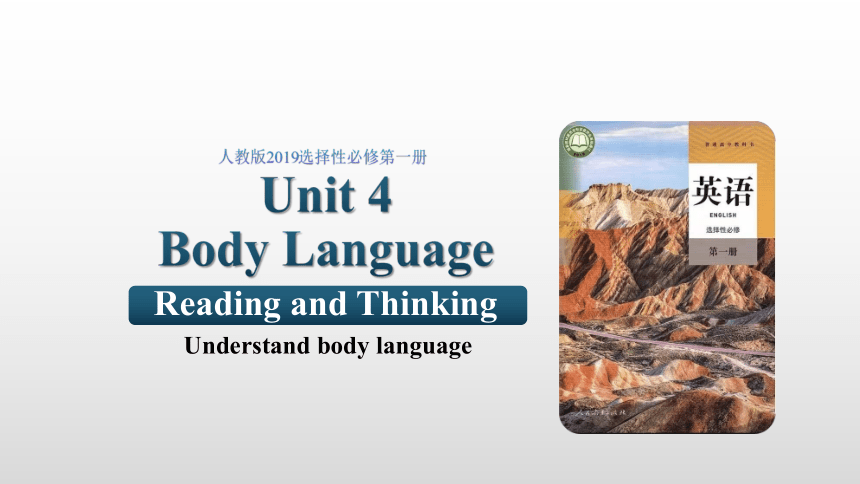 | |
| 格式 | pptx | ||
| 文件大小 | 34.6MB | ||
| 资源类型 | 教案 | ||
| 版本资源 | 人教版(2019) | ||
| 科目 | 英语 | ||
| 更新时间 | 2024-09-10 12:53:22 | ||
图片预览

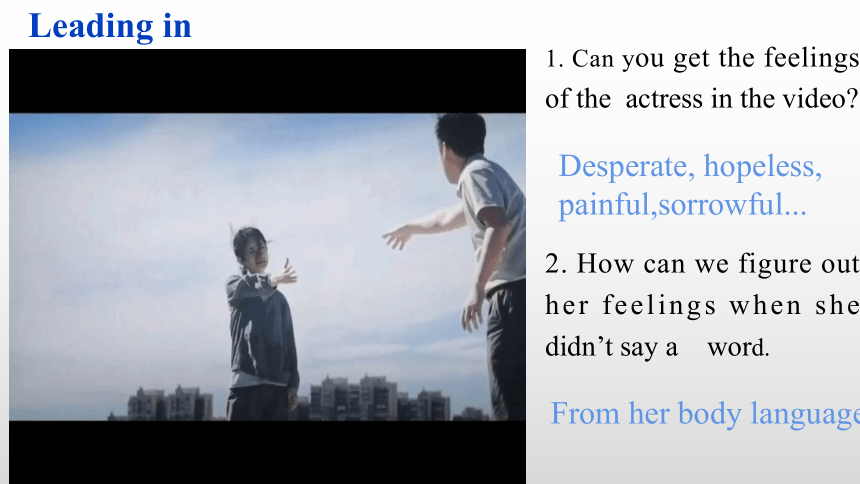
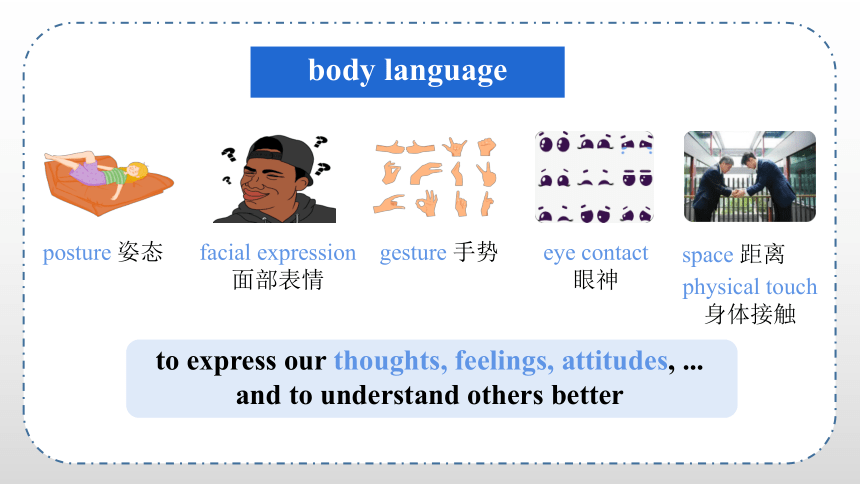
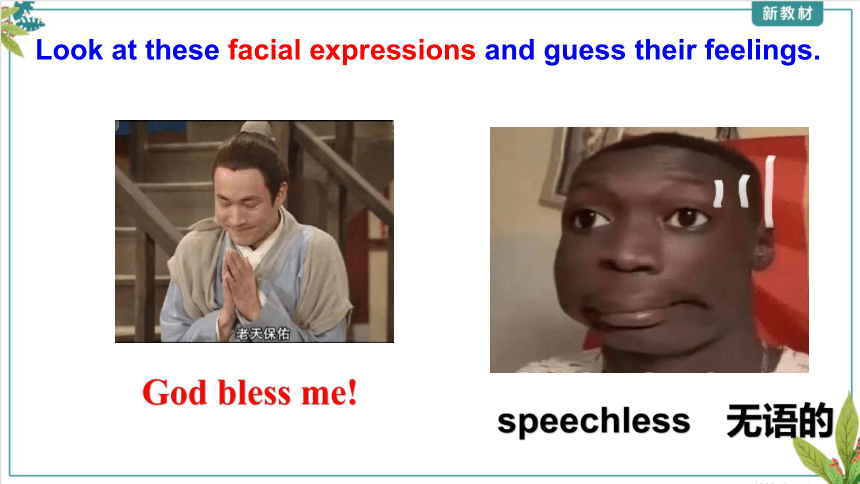
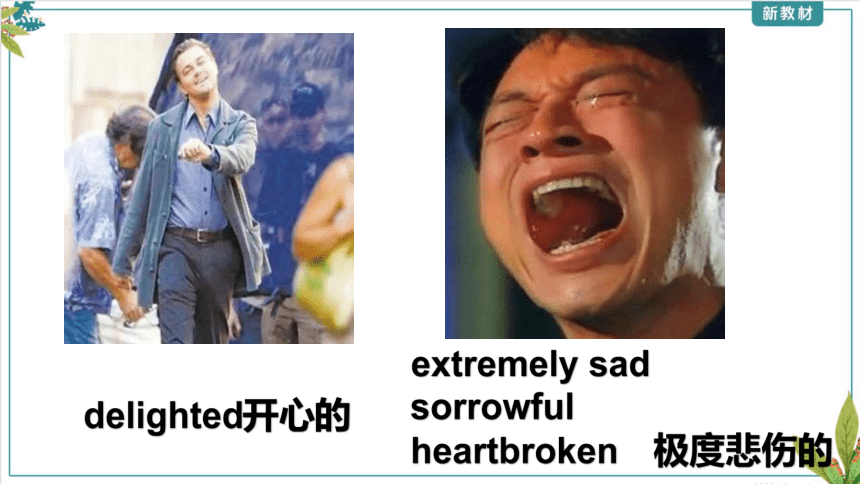
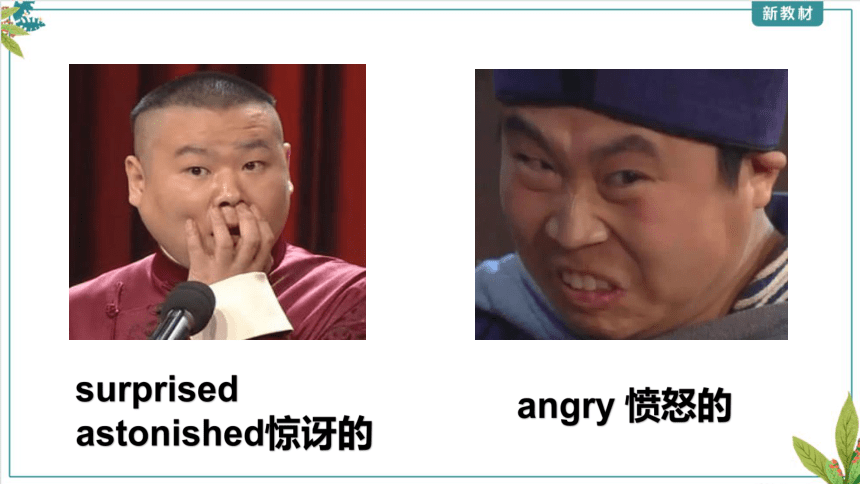
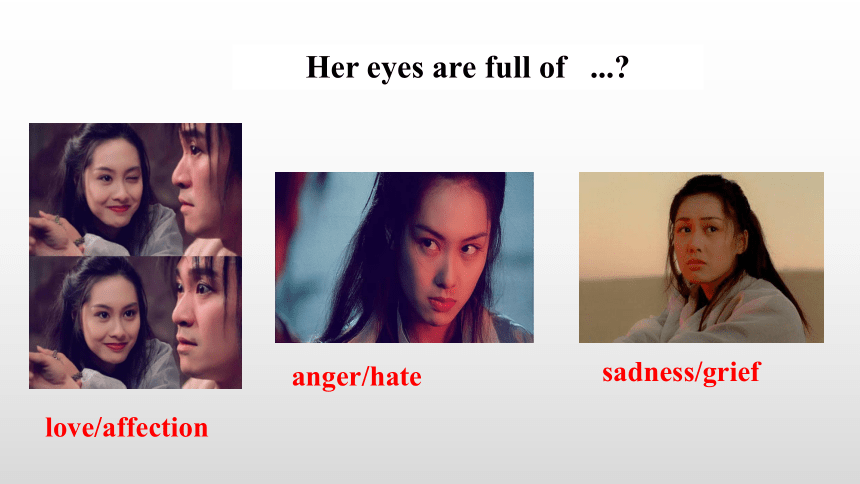
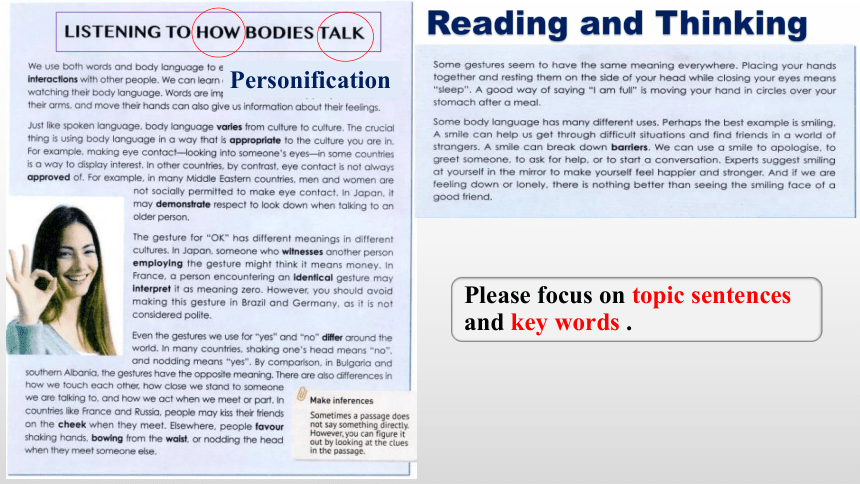
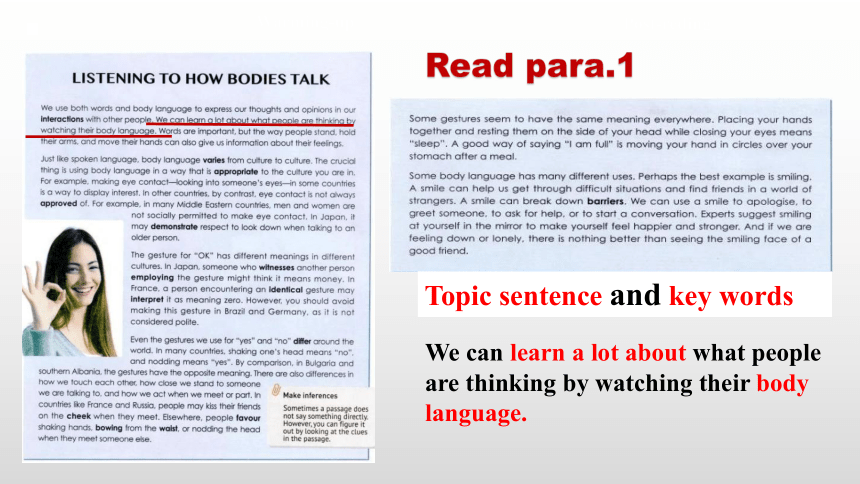
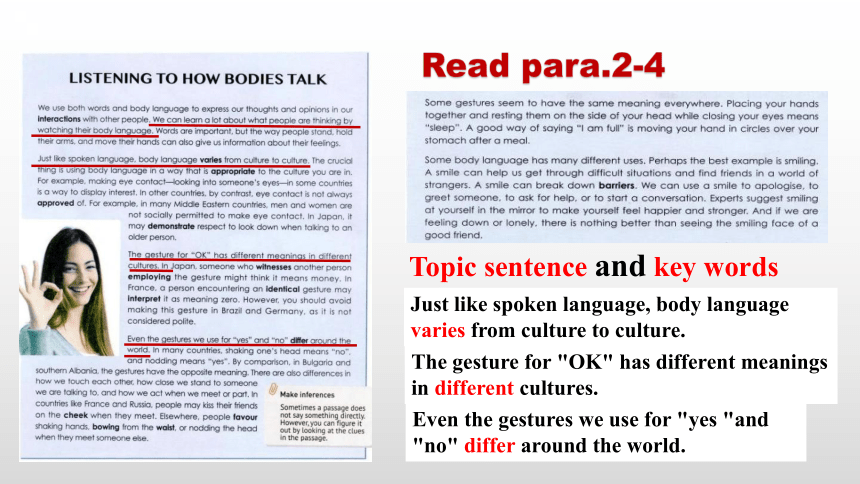
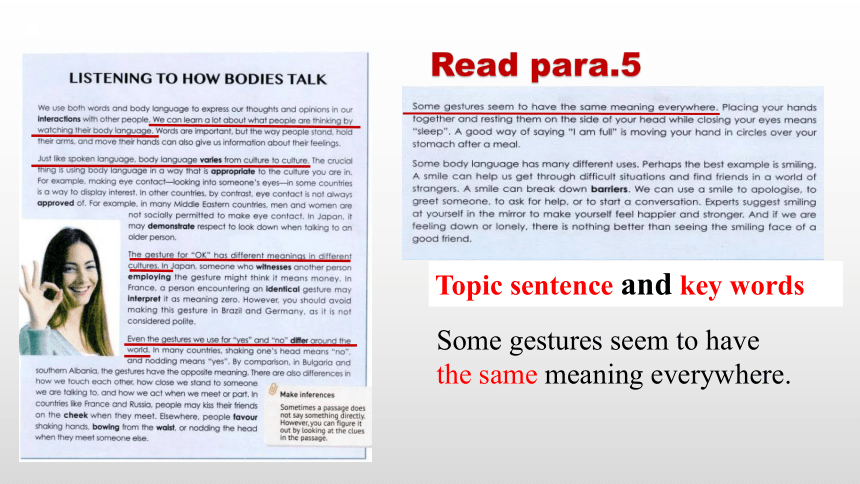
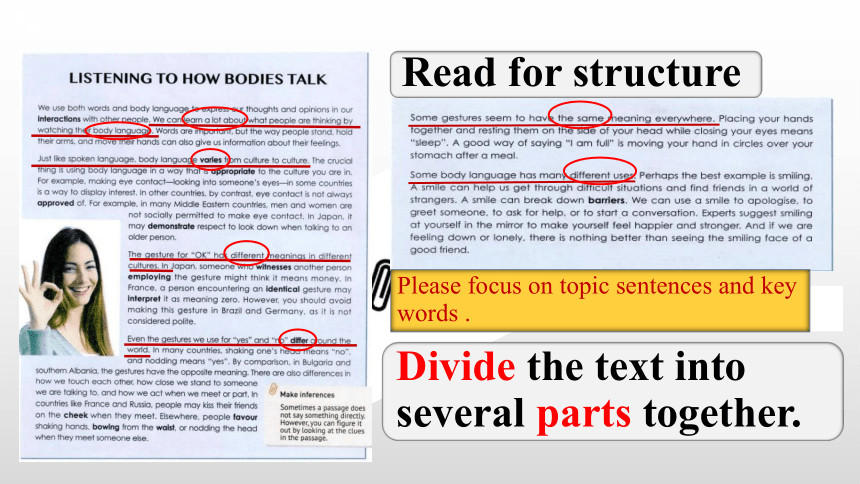
文档简介
(共30张PPT)
Reading and Thinking
Unit 4
Body Language
人教版2019选择性必修第一册
Understand body language
Leading in
1. Can you get the feelings of the actress in the video
2. How can we figure out her feelings when she didn’t say a word.
Desperate, hopeless, painful,sorrowful...
From her body language.
body language
posture 姿态
facial expression
面部表情
gesture 手势
eye contact
眼神
physical touch
身体接触
space 距离
to express our thoughts, feelings, attitudes, ...
and to understand others better
Look at these facial expressions and guess their feelings.
speechless 无语的
God bless me!
delighted开心的
extremely sad
sorrowful
heartbroken 极度悲伤的
surprised
astonished惊讶的
angry 愤怒的
添加标题
请在此添加文字说明,编辑文字。请在此添加文字说明,编辑文字。
Her eyes are full of ...
love/affection
anger/hate
sadness/grief
Reading and Thinking
Personification
Please focus on topic sentences and key words .
Read para.1
Topic sentence and key words
We can learn a lot about what people are thinking by watching their body language.
Post-reding
Warming-up
Read para.2-4
The gesture for "OK" has different meanings in different cultures.
Just like spoken language, body language varies from culture to culture.
Even the gestures we use for "yes "and "no" differ around the world.
Topic sentence and key words
Read para.5
Topic sentence and key words
Some gestures seem to have the same meaning everywhere.
Read para.6
Topic sentence and key words
Some body language has many different uses.
Read for structure
Please focus on topic sentences and key words .
Divide the text into several parts together.
Para.1
Words are important, but body language can also give us information about their feelings.
Para.2
Just like spoken language, body language varies from culture to culture.
Para.3
Para.4
The gesture for "OK" has different meanings in different cultures.
Even the gestures we use for "yes "and "no" differ around the world.
Differences
Para.5
Para.6
Some gestures seem to have the same meaning everywhere.
Some body language has many different uses.
The similarities
Different uses
2. What is the function of the last sentence in Paragraph 1
It is both a topic sentence(主题句) and a transitional sentence(过渡句).
Can you guess the meaning of the word “interaction”
according to the context
“Interaction” means “communication”.
1
2
Para 1
Read for the details
Identify how each paragraph is developed.
Read for details-Paragraph 2-4
Just like spoken language, body language varies from culture to culture. The crucial thing is using body language in a way that is appropriate to the culture you are in. For example, making eye contact—looking into someone’s eyes—in some countries is a way to display interest. In other countries, by contrast, eye contact is not always approved of. For example, in many Middle Eastern countries, men and women are not socially permitted to make eye contact. In Japan, it may demonstrate respect to look down when talking to an older person.
Para 2
topic sentence
supporting idea1
(example)
supporting idea2
(examples)
contrast
Respect
Japan
Read paragraph 2
The gesture for “OK” has different meanings in different cultures.
In Japan, someone who witnesses another person employing the gesture might think it means money. In France, a person encountering an identical gesture may interpret it as meaning zero. However, you should avoid making this gesture in Brazil and Germany, as it is not considered polite.
topic sentence
In Japan
In Brazil and Germany
contrast
In France
Para 3
Money
Japan
Zero
France
Not polite
Brazil and Germany
Read paragraph 3
Even the gestures we use for “yes” and “no” differ around the world. In many countries, shaking one’s head means “no”, and nodding means “yes”. By comparison, in Bulgaria and southern Albania, the gestures have the opposite meaning. There are also differences in how we touch each other, how close we stand to someone we are talking to, and how we act when we meet or part. In countries like France and Russia, people may kiss their friends on the cheek when they meet. Elsewhere, people favour shaking hands, bowing from the waist, or nodding the head when they meet someone else.
topic sentence
supporting idea1
(example)
supporting idea2
(example)
contrast
supporting idea1
(example)
supporting idea2
(example)
paralleling
paralleling
Para 4
topic sentence
How does the author develop this paragraph
No
Many countries
Yes
Bulgaria & Southern Albania
Yes
Many countries
No
Bulgaria & Southern Albania
Greeting
elsewhere
Greeting
elsewhere
Read paragraph 4
be impolite and offensive.
sleep
I'm full.
Everywhere
Read paragraph 5
There is one kind of body language which has the same meaning around the whole world. Do you know what it is
Smile
get through difficult situations (摆脱困境)
find friends (交到朋友)
apologise (道歉)
greet someone (问候)
ask for help (寻求帮助)
start a conversation (主动攀谈)
feel happier and stronger 感到快乐和坚强)
get comforted (得到安慰)
(Para. 6)
Some body language has many different uses --- smile.
Can you think of some other uses of smiling
break down barriers (打破隔阂)
Show confidence!
To hide the embarrassment. ......
Smile costs nothing,
but gives too much.
Some body language has many different uses. Perhaps the best example is smiling. A smile can help us get through difficult situations and find friends in a world of strangers. A smile can break down barriers. We can use a smile to apologise, to greet someone, to ask for help, or to start a conversation. Experts suggest smiling at yourself in the mirror to make yourself feel happier and stronger. And if we are feeling down or lonely, there is nothing better than seeing the smiling of a good friend.
Activity 5:Read Para.6 together and answer questions .
What are the benefits of smile
A smile costs nothing, but gives so much.
一个微笑不费什么事,却可能改变他人的一生。
smile
can help us get through __________situations
can help us find _________in a world of strangers
can break down ___________
can make people feel happier and ___________
difficult
friends
barriers
stronger
Can you think of some other uses of smiling
Group discussion
Discuss and offer some advice on body language in China to Joe.
Helpful Words and Phrases
shake hands;
nod the head;
a smiling face;
kiss on the cheek;
make eye contact;
look down;
ok sign;
place your hands...
and rest them on...;
point finger at;
shake legs;
stand/sit with crossed arms/ legs;
be appropriate to;
display interest;
demonstrate respect;
break down barriers;
In China,when people meet, it is proper for us to ________________________ rather than__________________, and keep _________________.
shake hands with others
kiss on the hand
a proper distance
Advice on body language in China
In China, it’s good manners to _____________ and have ___________ when talking to others.
keep smiling
eye contact
Advice on body language in China
In China,when we sit or stand, we’d better not __________________ or ______________________ .
sit with crossed legs
stand with crossed arms
Advice on body language in China
Reading and Thinking
Unit 4
Body Language
人教版2019选择性必修第一册
Understand body language
Leading in
1. Can you get the feelings of the actress in the video
2. How can we figure out her feelings when she didn’t say a word.
Desperate, hopeless, painful,sorrowful...
From her body language.
body language
posture 姿态
facial expression
面部表情
gesture 手势
eye contact
眼神
physical touch
身体接触
space 距离
to express our thoughts, feelings, attitudes, ...
and to understand others better
Look at these facial expressions and guess their feelings.
speechless 无语的
God bless me!
delighted开心的
extremely sad
sorrowful
heartbroken 极度悲伤的
surprised
astonished惊讶的
angry 愤怒的
添加标题
请在此添加文字说明,编辑文字。请在此添加文字说明,编辑文字。
Her eyes are full of ...
love/affection
anger/hate
sadness/grief
Reading and Thinking
Personification
Please focus on topic sentences and key words .
Read para.1
Topic sentence and key words
We can learn a lot about what people are thinking by watching their body language.
Post-reding
Warming-up
Read para.2-4
The gesture for "OK" has different meanings in different cultures.
Just like spoken language, body language varies from culture to culture.
Even the gestures we use for "yes "and "no" differ around the world.
Topic sentence and key words
Read para.5
Topic sentence and key words
Some gestures seem to have the same meaning everywhere.
Read para.6
Topic sentence and key words
Some body language has many different uses.
Read for structure
Please focus on topic sentences and key words .
Divide the text into several parts together.
Para.1
Words are important, but body language can also give us information about their feelings.
Para.2
Just like spoken language, body language varies from culture to culture.
Para.3
Para.4
The gesture for "OK" has different meanings in different cultures.
Even the gestures we use for "yes "and "no" differ around the world.
Differences
Para.5
Para.6
Some gestures seem to have the same meaning everywhere.
Some body language has many different uses.
The similarities
Different uses
2. What is the function of the last sentence in Paragraph 1
It is both a topic sentence(主题句) and a transitional sentence(过渡句).
Can you guess the meaning of the word “interaction”
according to the context
“Interaction” means “communication”.
1
2
Para 1
Read for the details
Identify how each paragraph is developed.
Read for details-Paragraph 2-4
Just like spoken language, body language varies from culture to culture. The crucial thing is using body language in a way that is appropriate to the culture you are in. For example, making eye contact—looking into someone’s eyes—in some countries is a way to display interest. In other countries, by contrast, eye contact is not always approved of. For example, in many Middle Eastern countries, men and women are not socially permitted to make eye contact. In Japan, it may demonstrate respect to look down when talking to an older person.
Para 2
topic sentence
supporting idea1
(example)
supporting idea2
(examples)
contrast
Respect
Japan
Read paragraph 2
The gesture for “OK” has different meanings in different cultures.
In Japan, someone who witnesses another person employing the gesture might think it means money. In France, a person encountering an identical gesture may interpret it as meaning zero. However, you should avoid making this gesture in Brazil and Germany, as it is not considered polite.
topic sentence
In Japan
In Brazil and Germany
contrast
In France
Para 3
Money
Japan
Zero
France
Not polite
Brazil and Germany
Read paragraph 3
Even the gestures we use for “yes” and “no” differ around the world. In many countries, shaking one’s head means “no”, and nodding means “yes”. By comparison, in Bulgaria and southern Albania, the gestures have the opposite meaning. There are also differences in how we touch each other, how close we stand to someone we are talking to, and how we act when we meet or part. In countries like France and Russia, people may kiss their friends on the cheek when they meet. Elsewhere, people favour shaking hands, bowing from the waist, or nodding the head when they meet someone else.
topic sentence
supporting idea1
(example)
supporting idea2
(example)
contrast
supporting idea1
(example)
supporting idea2
(example)
paralleling
paralleling
Para 4
topic sentence
How does the author develop this paragraph
No
Many countries
Yes
Bulgaria & Southern Albania
Yes
Many countries
No
Bulgaria & Southern Albania
Greeting
elsewhere
Greeting
elsewhere
Read paragraph 4
be impolite and offensive.
sleep
I'm full.
Everywhere
Read paragraph 5
There is one kind of body language which has the same meaning around the whole world. Do you know what it is
Smile
get through difficult situations (摆脱困境)
find friends (交到朋友)
apologise (道歉)
greet someone (问候)
ask for help (寻求帮助)
start a conversation (主动攀谈)
feel happier and stronger 感到快乐和坚强)
get comforted (得到安慰)
(Para. 6)
Some body language has many different uses --- smile.
Can you think of some other uses of smiling
break down barriers (打破隔阂)
Show confidence!
To hide the embarrassment. ......
Smile costs nothing,
but gives too much.
Some body language has many different uses. Perhaps the best example is smiling. A smile can help us get through difficult situations and find friends in a world of strangers. A smile can break down barriers. We can use a smile to apologise, to greet someone, to ask for help, or to start a conversation. Experts suggest smiling at yourself in the mirror to make yourself feel happier and stronger. And if we are feeling down or lonely, there is nothing better than seeing the smiling of a good friend.
Activity 5:Read Para.6 together and answer questions .
What are the benefits of smile
A smile costs nothing, but gives so much.
一个微笑不费什么事,却可能改变他人的一生。
smile
can help us get through __________situations
can help us find _________in a world of strangers
can break down ___________
can make people feel happier and ___________
difficult
friends
barriers
stronger
Can you think of some other uses of smiling
Group discussion
Discuss and offer some advice on body language in China to Joe.
Helpful Words and Phrases
shake hands;
nod the head;
a smiling face;
kiss on the cheek;
make eye contact;
look down;
ok sign;
place your hands...
and rest them on...;
point finger at;
shake legs;
stand/sit with crossed arms/ legs;
be appropriate to;
display interest;
demonstrate respect;
break down barriers;
In China,when people meet, it is proper for us to ________________________ rather than__________________, and keep _________________.
shake hands with others
kiss on the hand
a proper distance
Advice on body language in China
In China, it’s good manners to _____________ and have ___________ when talking to others.
keep smiling
eye contact
Advice on body language in China
In China,when we sit or stand, we’d better not __________________ or ______________________ .
sit with crossed legs
stand with crossed arms
Advice on body language in China
